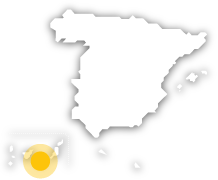
Gran Canaria Biosphere Reserve

A continent in miniature
The Gran Canaria Biosphere Reserve was declared a Biosphere Reserve by the UNESCO in 2005. It spans across 43% of the island's territory and a large marine area on the southwest coast.
Gran Canaria is located in the archipelago of the Canary Islands, between Fuerteventura and Tenerife. The island, of volcanic origin, has a rounded shape and its highest point is located in the centre, at Pico de las Nieves (1,949 meters), with a conical-shaped topography. Its altitude and the characteristics of its peculiar relief make possible the existence of different microclimates and habitats. Thus, due to its enormous diversity of landscapes, Gran Canaria is known by the nickname “continent in miniature”: From ravines and mountain peaks, to beaches, forests and cliffs. Almost half of its 1,560 square kilometres of territory are within the Biosphere Reserve area that covers, in the southwest of the island, the municipalities of Aldea de San Nicolás, Artenara and Tejeda; the entire region of San Bartolomé de Tirajana, Agaete and Mogán located at an altitude above 300 metres; the marine strip; and a small part of the Vega de San Mateo, in the centre of the island, included within the El Nublo Rural Park. This area includes natural parks such as Inagua, Tamadaba and Pilancones and the immense depression of the Tejada Basin, from whose mountains a stormwater drainage network runs through the ravines and agricultural valleys to the coast. In general, three types of ecosystems are distinguished: an arid and semi-arid environment, with vegetation dominated by cardones and tabaibas; a sub-humid environment, characterised by Canary Island pine forests (a unique species in the world); and a humid transitional environment, with fayal-brezal vegetation and vestiges of laurisilva. The biodiversity of its coastline is also rich, with populations of loggerhead turtles and cetaceans such as the bottlenose dolphin and the Risso's pilot whale.
Gran Canaria Biosphere Reserve
Gran Canaria (Canary Islands)
Gran Canaria (Canary Islands):
- San Bartolomé de Tirajana
- Aldea de San Nicolás, la
- Tejeda
- Artenara
- Vega de San Mateo
- Mogán
- Agaete
Activa JS
What you need to know
-
Cultural information
Tourism is the main activity, although always marked by respect for nature. Awareness on the island is very high, with a tendency to adopt sustainable practices in a wide variety of areas, such as artisanal fishing, rural tourism and irrigation systems that optimise water consumption. In this sense, its citizens are a role model, as households in Gran Canaria consume the least water in the European Union.
-
Environmental information
Despite its small size, Gran Canaria boasts extraordinary biodiversity, where you can appreciate the unique characteristics of the Macaronesian natural environment, as well as numerous species of endemic flora and fauna. Of the 600 species of flora recorded in the Biosphere Reserve, 95 are native to Gran Canaria, 101 to the Canary Islands and 32 to Macaronesia. As for terrestrial fauna, birds and reptiles abound, with endemic species such as the blue finch and the Canary Island lizard, while mammals such as dolphins, porpoises and whales can be found in its waters.
-
Information for visits
Gran Canaria can be reached by air or sea easily from Las Palmas de Gran Canaria (the international airport is just 18 kilometres from the city). In addition, the island is connected to the rest of the Canary Islands archipelago via various inter-island air and sea lines. Renting a car is a good option for exploring the island, as the maximum distance between two points is less than 47.5 kilometres.


